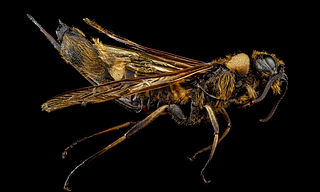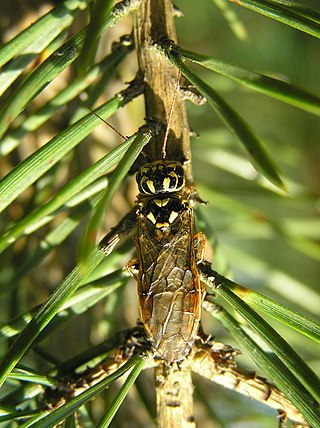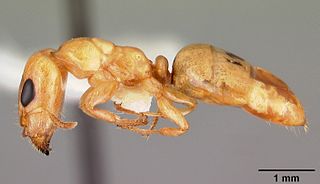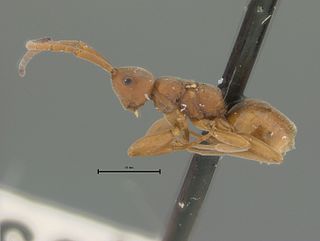Related Research Articles

The Scoliidae, the scoliid wasps, are a family of about 560 species found worldwide. They tend to be black, often marked with yellow or orange, and their wing tips are distinctively corrugated. Males are more slender and elongated than females, with significantly longer antennae, but the sexual dimorphism is not as apparent as in the Tiphiidae.

Horntail or wood wasp are any of the 150 non-social species of the hymenopteran family Siricidae, a type of wood-eating sawfly. The common name "horntail" derives from the stout, spine-like structure at the end of the adult's abdomen, which is used to pierce the host's bark to allow the eggs to be inserted into the wood. A typical adult horntail is brown, blue, or black with yellow or red parts, and may often reach up to 4 cm (1.6 in) long. The pigeon horntail can grow up to 5 cm (2.0 in) long, among the longest of all Hymenoptera.

Alexandr Pavlovich Rasnitsyn is a Russian entomologist, expert in palaeoentomology, and Honored Scientist of the Russian Federation (2001). His scientific interests are centered on the palaeontology, phylogeny, and taxonomy of hymenopteran insects and insects in general. He has also studied broader biological problems such as evolutionary theory, the principles of phylogenetics, taxonomy, nomenclature, and palaeoecology. He has published over 300 articles and books in several languages. In August 2008 he was awarded the Distinguished Research Medal of the International Society of Hymenopterists.

Anaxyelidae is a family of incense cedar wood wasps in the order Hymenoptera. It contains only one living genus, Syntexis, which has only a single species, native to Western North America. Fossils of the family extend back to the Middle Jurassic, belonging to over a dozen extinct genera, with a particularly high diversity during the Early Cretaceous. Syntexis lay eggs in the sapwood of conifers, preferring recently burnt wood.

The Xyelidae are a comparatively species-poor family of sawflies comprising about 80 extant species in five genera worldwide and is the only family in the superfamily Xyeloidea. The fossil record of the family is extensive, comprising more than 120 species and including the oldest fossil Hymenoptera species dating back to the Triassic, between 245 and 208 million years ago. Xyelidae are to be regarded as living fossils since they represent one of the oldest lineages of insects and include still extant forms.

Cephoidea is a small superfamily within the Symphyta, commonly referred to as stem sawflies, containing some 100 species in 10 genera in the living family, Cephidae, plus another 17 genera in the extinct family Sepulcidae. Most species occur in the Northern Hemisphere, especially in Eurasia. The larvae are stem borers in various plants, especially grasses, but sometimes other herbaceous plants, shrubs, or trees. A few are pests of cereal grains. They are exceptionally slender for symphytans, often resembling other types of wasps, and they are the only Symphyta which lack cenchri. They are sometimes postulated to be the sister taxon to the Apocrita, though the Orussidae are more commonly considered such.

The Megalodontesidae are a small family of sawflies, containing a single living genus, Megalodontes, with some 40 species restricted to the temperate regions of Eurasia. Larvae of Megalodontesidae feed on herbaceous plants. They are distinguished from the closely related Pamphiliidae by their serrate or pectinate antennae.

Pamphiliidae is a small wasp family within Symphyta, containing some 200 species from the temperate regions of North America and Eurasia. The larvae feed on plants, using silk to build webs or tents, or to roll leaves into tubes in which they feed, thus earning them the common names leaf-rolling sawflies or web-spinning sawflies. Some species are gregarious and the larvae live in large groups. Fossils of Pamphiliidae have been dated to the Jurassic period.

The Mymarommatoidea are a very small superfamily of microscopic fairyfly-like parasitic wasps. It contains only a single living family, Mymarommatidae, and three other extinct families known from Cretaceous aged amber. Less than half of all described species are living taxa, but they are known from all parts of the world. Undoubtedly, many more await discovery, as they are easily overlooked and difficult to study due to their extremely small size.

The Gasteruptiidae are one of the more distinctive families among the apocritan wasps, with surprisingly little variation in appearance for a group that contains around 500 species in two subfamilies and with 6 genera worldwide. They are members of Evanioidea.

Evaniidae is a family of parasitoid wasps also known as ensign wasps, nightshade wasps, hatchet wasps, or cockroach egg parasitoid wasps. They number around 20 extant genera containing over 400 described species, and are found all over the world except in the polar regions. The larvae of these solitary wasps are parasitoids that feed on cockroaches and develop inside the egg-cases, or oothecae, of their hosts.

Pachycondyla is a ponerine genus of ants found in the Neotropics.
Andyrossia is an extinct genus of wasp known from the Late Cretaceous Weald Clay of southern England, containing a single species, Andyrossia joyceae. It was first named by Rasnitsyn and Jarzembowski in 1998 as Arossia; this was later realised to be a junior homonym of a barnacle subgenus containing Concavus panamensis, and was replaced by the name Andyrossia in 2000.
Cretevania is an extinct genus of Evaniidae, which lived in what is now China, Burma, England, Lebanon, Mongolia, Russia and Spain during the Cretaceous period. the genus was described by Rasnitsyn in 1975, and the type species is Cretevania minor.
Apis nearctica is an extinct species of honey bee which existed in what is now Nevada during the Middle Miocene period. It was discovered at Stewart Valley, Nevada, and described by Michael S. Engel, Ismael A. Hinojosa-Díaz, and Alexandr P. Rasnitsyn in 2009.
Idelinellidae is a family of fossil cockroach-like insects. They closely resemble members of the family Stenoneuridae, and consist of the following species:

Gesomyrmex is a genus of ants in the subfamily Formicinae. The genus contains six extant species, known from the Indomalayan realm, and nine fossil species. Of the extant species, four are known only from workers and two only from females. The extinct species "G. expectans" and "G. miegi", formerly placed in the genus, were excluded by Dlussky et al.., 2009.

Maimetshidae is an extinct family of wasps, known from the Cretaceous period. While originally considered relatives of Megalyridae, they are now considered to probably be close relatives of Trigonalidae.

Aptenoperissus is a genus of extinct wasp with eight described species, placed into the monotypic family Aptenoperissidae. The type species Aptenoperissus burmanicus resembles a mix between a grasshopper, an ant, and a wasp. It was described by a group of researchers from Oregon State University in a paper released online in October 2016. The piece of 100 million year old Burmese amber that it was preserved in was found in the Hukawng Valley of Myanmar in Southern Asia. A new family, Aptenoperissidae, was described to accommodate this insect. Species of Aptenoperissus were wingless, with a strong stinger. The creature had long legs making it perfect for jumping higher than most insects. Subsequently additional species were described from the Myanmar amber: A. amabilis, A. delicatus, A. formosus, A. etius, A. magnifemoris, A. pusillus and A. zonalis. Initially placed in Ceraphronoidea, later studies placed it in Stephanoidea.

Embolemidae is a family of small solitary parasitoid wasps with around 70 species in 2 genera distributed around the world. The few species whose biology is known are parasites on planthopper nymphs of the families Achilidae and Cixiidae. There is debate regarding the status of the genus named Ampulicomorpha by Ashmead in 1893, generally considered now to be a junior synonym of Embolemus (e.g.,), though some authorities dispute this (e.g.,)
References
- ↑ Alexandr P. Rasnitsyn & Denis J. Brothers (2009). "New genera and species of Maimetshidae (Hymenoptera: Stephanoidea s.l.) from the Turonian of Botswana, with comments on the status of the family". African Invertebrates . 50 (1): 191–204. doi: 10.5733/afin.050.0108 .